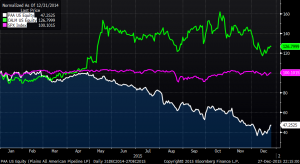We hope that all of you who are reading this commentary are enjoying the holiday season and getting an opportunity to spend time with friends and family. Happy Holidays to all!
As we approach year end, we are reminded that investors commonly check their investment returns each calendar year. However, we cannot help but wonder why most of the investment world regularly uses this period to assess results. After all, our investment time horizon is much, much longer than that, especially when it comes to investing for retirement. Goals that involve saving money for, or spending money during, retirement represent long- rather than short-term objectives.
Using the calendar year as a basis for the measurement of investment performance forces us to focus on beating the market every year. However, this is impossible to do. It is not at all surprising that last March The New York Times reported that not even one of 2,862 equity mutual funds outperformed the market in each of the last five years. However, over the entire period roughly one of five funds did surpass the S&P 500. While this is still not a great result, it certainly reflects a much better outcome than would be found looking at performance based on the results of each year individually.
At the same time, it is always important for investors to regularly review their investment successes and failures. While our goal is to find investments that will add value to client portfolios, we know that not every security we add to client portfolios will achieve our desired result. When an investment does not meet our objectives, it is important to review both the process used to make the decision and the reasoning behind it.
Each investment can have a good or bad outcome. Similarly, the process used to make the decision can be good or bad. Good processes and good outcomes deliver deserved success, just as bad processes and bad outcomes represent a form of poetic justice. Conversely, bad processes that yield good outcomes are just dumb luck. Investors often confuse the two.
For our clients in 2015, on a relative basis, the investment that has detracted the most from performance has been Plains All-American Pipeline, L.P. (PAA); the security that has benefited results the most has been Cal-Maine Foods, Inc. (CALM)[i] (The chart that follows shows the performance of both relative to the S&P 500.)
Given that we continue to hold both securities in client portfolios, it is reasonable to conclude that we believe our success with Cal-Maine is a “Deserved Success” while Plains’ disappointing returns are a “Bad Break.”
Cal-Maine produces, grades, packages, markets, and distributes shell eggs. Its business is primarily based in the southern U.S. We believe it is a well-managed company and that management allocates capital well. During the course of the year, the company’s share price increased rapidly as an avian flu outbreak led to the death of roughly 48 million chickens in a dozen U.S. states, largely in the Midwest. Because Cal-Maine’s business was not impacted by the outbreak, it benefited meaningfully.
Plains engages in the transportation, storage, terminalling, and marketing of crude oil, natural gas liquids (NGL), natural gas, and refined products in the United States and Canada. It has been hurt by the continued weakness in oil prices. Investors are also concerned that the company could potentially cut its generous dividend – the shares currently yield nearly 13%. Plains’ management continues to maintain that it will not need to cut its dividend. While we have faith in management, we are watching Plains and its industry carefully. The company is a frequent topic of discussion at our weekly Investment Committee meetings.
We hope that 2016 is a good year for all of our clients and friends that are reading this commentary (and their families). From an investment perspective, we hope it provides more CALM’s and fewer PAA’s.
[i] Plains All-American Pipeline, L.P. (PAA) and Cal-Maine Foods, Inc. (CALM) are currently on BWFA’s “Buy/Hold” list and may be held in client portfolios.




